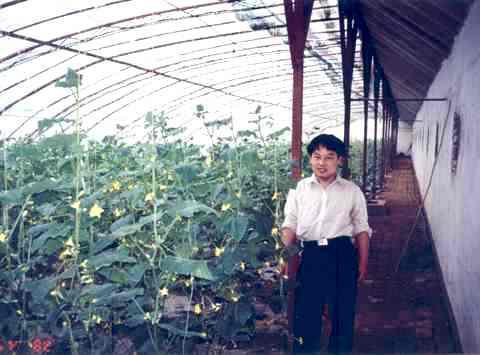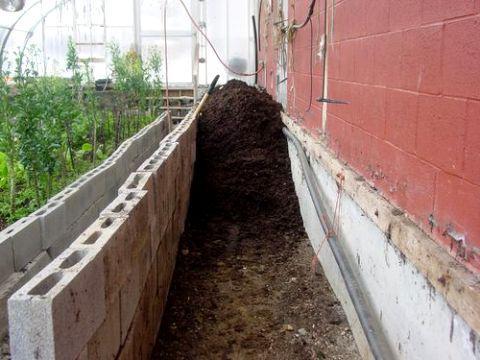Most people have the opinion that Chinese goods are always consumer goods, not of high quality, and their technology is either far from perfect or borrowed from someone. Chinese greenhouses completely destroy these stereotypes. Their design is very simple, material investments are minimal, and the results are stunning. With the introduction of these unusual vegetarians into the Chinese agro-industrial complex, it has become possible to provide the country's 1.5 billion people with cheap fruits and vegetables all year round. Greenhouses from China, having proved in practice their high profitability, began to conquer the world market. Now they are popular in all temperate countries, including Russia.
Principle of operation
Chinese greenhouses, although they came to us from China, have a Russian counterpart. Back in the middle of the last century, a simple physics teacher Alexander Ivanov came up with solar-vegetariums, that is, designs that use the energy of the sun. The Chinese modified this model a bit, leaving the same principle of operation. Their first greenhouse appeared in 1978. It works in the same way as the Ivanov’s veggie, due to the free energy of our star. At any point in Russia (except the Far North), the sun shines all year quite well, only in the summer its rays fall on the Earth at an angle close to 90 °, and in winter their angle of incidence decreases to 20-40 °. A slight discrepancy in values depends on the geographical latitude of the area. At a small angle of incidence, the rays seem to glide over the surface, so they do not give it heat. If you make a wall of the greenhouse with a slope that allows you to capture all the energy of winter sunshine, they will heat this wall in the same way as they heat the earth in summer. This principle is the basis of Chinese vegetarians. Additionally, such structures are heated only in severe frosts.
Chinese greenhouses: description
We are used to transparent greenhouses on all sides, because plants should receive as much light as possible. They are arched or in the shape of a house - it does not matter, the main thing is that all their walls let in sunlight. The Chinese left only one wall transparent, and the rest is built of brick, cinder block, concrete, clay or earth - anything, the main thing is that they be massive. Their thickness is maintained within 1.5-2 meters, depending on the climate of the area. Where winters are relatively warm, for example, in the Krasnodar Territory, walls up to 1-1.5 meters thick can be erected. Outside, they must be covered with some kind of insulation (foamglass, foamed polymers with a thickness of 150 mm, mats with straw). The transparent wall is tilted and has the appearance of a semi-arch. For its construction, reinforced film or polycarbonate is used. As you can see, Chinese greenhouses have a somewhat unusual and yet simple design. The photo captured one of them from the inside.

If the landscape features of the site allow, such a vegetarian can be built into an earthen hill. This option has two significant advantages:
1. The thickness of the earth will very well protect the greenhouse from the cold.
2. Only two side walls will have to be erected, which means significant savings in both money and labor.
It is even more economical to attach a greenhouse to the wall of a residential building.
When choosing any option near one of the side walls, it is necessary to construct an utility pantry. In it, the Chinese store tools, fertilizers, chemicals for processing plants and other necessary things.
Features of internal heating
Chinese greenhouses, where additional heating is used, are built in regions with severe winters. For this purpose, use a conventional stove-stove, working on coal or wood, electric or gas heaters. In regions where it is never colder in winter -15 ° C, you can do only with the energy of the sun. From dawn to dusk, its rays penetrate the greenhouse, heat the walls and the ground, and at night the accumulated heat is given to air and plants. Some designs provide additional heating without using a stove.

It is done like this: plastic pipes with a diameter of 110 mm or more are laid around the perimeter of the greenhouse. They are buried in the ground by about 300 mm, but so that two ends stick out from the side of the transparent wall from the ground. They come from the room warm air. In the opposite wall, where there are also pipe openings, fans are installed, which make air circulate through the system. These devices partly solves the issue of ventilation. Alternatively, black tanks are installed near the north wall. The sun warms them all day, and at night they give off heat to plants.
Features of outdoor heating
In addition to internal heating, Chinese greenhouses are equipped with outdoor. On their vegetarians, the Chinese are installing a special system that works on the principle of sun awnings. Its design includes a roll of rice husk protective film and a manual or automatic swing mechanism. In the evening, the film is unwound and covered with a greenhouse, and in the morning they are rolled back. Instead of a film of rice husks, reed panels are allowed. They are made light, because they only cover the transparent wall of greenhouses. In addition, the thickness of the reed panels should not prevent them from twisting into a roll and retain heat as much as possible.
A pantry attached to the end wall also helps to keep warm in vegetarians, because when workers enter it from the street, frosty air enters only this small utility room, without directly reaching the greenhouse.
Internal arrangement
Chinese greenhouses for growing strawberries, tomatoes, any other vegetables must have a drip irrigation system. Inside the vegetarians, a humidity and temperature control system is placed. The beds are often arranged using agrofibre, which provides additional heating of plant roots. In industrial greenhouses , there is a place for a compost pit or plants and animals, for example, pigs, are grown simultaneously. These operating features make it possible to obtain organic fertilizers. The Chinese make beds in the south-north direction, and with a slight slope from the back wall. It is believed that with this arrangement, the soil warms up in the best way. For strawberries, racks are constructed in several rows on the back wall of greenhouses. They are placed at such a level that each plant has the opportunity to receive the required amount of light. In the rest of the area they plant stunted crops.
Best location
Since Chinese greenhouses use the energy of our luminary, they must be located on the site so that it is possible to take maximum heat from it. The back wall of the vegetarium should face north. It is made deaf, without a single window and without doors. It can be drowned in an earthen hill or be common with the house. The transparent wall should face south. Two sidewalls are located respectively in the western and eastern directions. We are most in demand for greenhouses polycarbonate due to its strength. The Chinese prefer to coat their vegetarians with a milky blue super strong film, whose service life is 3 years or more. It is believed that it not only uniformly disperses the light throughout the room, but also transmits only rays with the necessary wavelengths to the plants. It is important to find a place for the greenhouse so that its southern wall is not blocked by anything, for example, a high fence or other buildings on the site.
How to build a solar vegetarian
No matter what the Chinese greenhouses are for - for growing cucumbers, tomatoes or cabbage, they are built according to a single technology. The ideal option is when the vegetarian is attached to a residential building. On the Russian market, it is precisely these designs that are mainly sold. In the kit for the components of the greenhouse comes a detailed diagram and assembly instructions. Separately, you can purchase a protective film, which is sold for meters. If there is a desire to build a Chinese greenhouse from improvised materials, it is important to make the correct angle of inclination of the transparent wall, which should be the smaller the north of the area. It is also necessary to provide for adequate ventilation in a home-made vegetarian without violating its tightness. If you comply with all the rules and do not violate the technology, a do-it-yourself greenhouse will be no worse than purchased from Chinese manufacturers.
Reviews
Russian farmers are just starting to try out Chinese greenhouses. Reviews about their performance are still few. Noted advantages:
- the ability to harvest in winter and summer;
- relatively low construction costs (if possible, attach a greenhouse to the house);
- less fuel is consumed for heating.
Noted shortcomings and difficulties:
- it is difficult to buy the necessary components;
- in the Moscow region and other areas with severe winters, it is necessary to additionally heat the greenhouse, which reduces its profitability and increases maintenance costs;
- not using the fuel released during the combustion of CO 2 , you need to look for another source of carbon dioxide, which plants need for life;
- a warm blanket (a film of rice husks) weakly holds heat;
- In regions with a warmer climate, it is necessary to arrange additional ventilation.